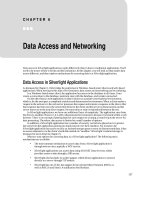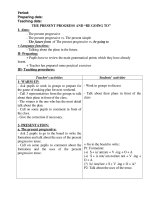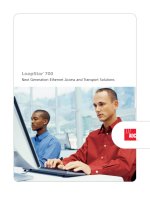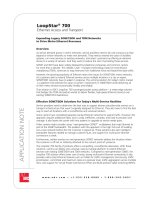ABS PICTURE BOX: COMMUNICATING ACCESS AND BENEFIT-SHARING TO COMMUNITIES ACROSS AFRICA ĐIỂM CAO
Bạn đang xem bản rút gọn của tài liệu. Xem và tải ngay bản đầy đủ của tài liệu tại đây (3.35 MB, 32 trang )
<span class="text_page_counter">Trang 3</span><div class="page_container" data-page="3">
the participants of the 2018 ABS Expert Workshop in Limuru, Kenya
<i>Layout/Design: Katerina Sonntagova, www.mossandsea.studio</i>
Published by: Natural Justice
63 Hout Street, Mercantile Building Cape Town, 8000, South Africa
<b>The ABS Capacity Development Initiative</b> contributes to achieving the Sustainable Development Goals (SDGs) by supporting the implementation of the Nagoya Protocol on Access and Benefit-sharing (ABS), framed by the third objective of the Convention on Biological Diversity (CBD). Through targeted support services the ABS Initiative facilitates three core processes: developing ABS regulatory and institutional frameworks, negotiating fair and equitable ABS agreements and integrating indigenous peoples and local communities in respective procedures.
<b>Natural Justice</b> is an African organization specialized in the interface between human rights and environmental law, and works for the pursuit of social and environmental justice. Natural Justice is committed to supporting the participation of indigenous peoples and local communities in the implementation of ABS through support for the development of community protocols and other comparable tools, advice and legal assistance for negotiation of fair and equitable ABS agreements; as well as research and advice on integrating community rights into national, regional and international frameworks related to ABS and the protection of traditional knowledge.
</div><span class="text_page_counter">Trang 4</span><div class="page_container" data-page="4"><b> i</b>
The Access and Benefit-sharing Picture Box (ABS Picture Box) is a communication tool for individuals, non-governmental organizations (NGO), civil society groups, community-based organizations (CBO) or others working with indigenous peoples and local communities across Africa. It is intended to be an interactive tool, which supports outreach work on issues relating to access to genetic resources and associated traditional knowledge as well as sharing the benefits arising from their utilization (Access and Benefit-sharing, ABS). Communicating this complex topic in remote areas where there are low literacy levels and potentially across language barriers remains a challenge. There is an identified need for ABS communication materials that are especially adapted for use in rural and community contexts. The aim is to enable indigenous peoples and local communities to play a meaningful role in ABS implementation and ultimately to ensure fair and equitable benefit sharing if their traditional knowledge and genetic resources are utilized.
The idea for this ABS Picture Box was born at a workshop organized by the ABS Capacity Development Initiative (ABS Initiative) and its partner Natural Justice, in Limuru, Kenya in early 2018. The workshop was attended by participants from across Africa, including representatives from indigenous peoples and local communities, government, civil society, research institutions and business, as well as a few international experts, who came together to develop ideas about how to more effectively communicate ABS to different actors within communities, including traditional institutions/leaders, indigenous peoples’ organisations and CBOs, members of the broader community not directly involved in ABS negotiations, and local government officials. During the workshop, the participants developed communication objectives, key messages and ideas about the appropriate communication media. Further information can be found in the full report<small>1</small>. The concept of a picture box was identified as a suitable medium for informing the wider community about the value of genetic resources and traditional knowledge, the ABS process and their role in this process. The role of indigenous peoples and local communities in the ABS process is determined by the national ABS regulatory framework. The assumption is made that these communities, with whom the picture cards are used, have been or will be involved in ABS in some way in the near future. While the participants may not necessarily be among the key players involved directly in the process, they may be involved indirectly, for example, through community consultation and decision-making processes or as potential beneficiaries of benefit-sharing agreements.
<small>1o/countries-and-regions/africa/kenya/expert-workshop-develop-ing-abs-communication-materials-for-indigenous-peoples-and-local-communities/</small>
<b>We hope that the ABS Picture Box will help promote the understanding of ABS among local communities in many different contexts. If you have any comments or suggestions for improvement, please do not hesitate to contact us at </b>
<i><b> or </b></i>
</div><span class="text_page_counter">Trang 5</span><div class="page_container" data-page="5"><b>ii </b>
In the Picture Box, there are eight different cards. The picture cards cover the following topics:
<b>Biological resources</b> - the value of local biodiversity for indigenous peoples and local communities
<b>Traditional knowledge</b> associated with the use of such biological resources
<b>Use and users</b> - the value of biodiversity and associated traditional knowledge for others Local biodiversity and associated traditional knowledge in <b>value chains</b>
<b>Asking first</b> - Prior Informed Consent
<b>Benefit-sharing</b> and types of benefits
<b>Making a promise</b> - access and benefit-sharing agreements
<b>The rights and responsibilities</b> of different actors in ABS
Each picture card contains illustrations to be shown to the participants and is accompanied by instructional text for the facilitator (see section below: “ABS Picture Box Manual”). This text includes:
<i><b>The objective/s – what participants should understand or be capable of doing after the ABS picture card </b></i>
has been explained.
<i><b>Tips on using the image – suggestions on how to use the image with the participants and how to start </b></i>
the discussion, including small versions of the images pointing out the elements that can be discussed.
<i><b>Suggested discussion questions – these questions can elicit any existing knowledge. They should </b></i>
also help the facilitator to start the discussion and communicate the key messages about traditional knowledge, genetic resources and ABS. As they are guiding questions only, the facilitator does not necessarily have to ask all of them, or may want to develop other questions, depending on the context.
<i><b>The key messages – the most important points. If these are not dealt with whilst using the image or </b></i>
while working through the discussion questions, the facilitator should make sure these are explained. These key messages should also be repeated to help the participants understand and remember the information. The facilitator is, of course, free (and encouraged) to adapt the key messages on each card according to the community with whom he or she is communicating.
The facilitator should try to make a connection between the images on the picture cards and the discussion questions and key messages.
Each ABS picture card addresses a particular aspect of ABS, but all of the cards are related to one another. In some cases, it makes sense to use the cards in a specific order but otherwise, <b>the cards can be used in whatever order the facilitator sees fit</b>.
ABS Picture Box design, contents and use
</div><span class="text_page_counter">Trang 6</span><div class="page_container" data-page="6"><b> iii</b>
<i><b>Before the exchanges with communities…</b></i>
The ABS Picture Box is for individuals, NGOs, civil society groups, community-based organizations or others working with indigenous peoples and local communities. The assumption is made that the facilitator using the picture cards already has some understanding of ABS but may not necessarily be an expert. For this reason, this picture box includes links to important background information on ABS to help with preparation, as well as information on how to use the picture cards.
It is important that the facilitator is informed about existing national ABS process rules and procedures, as well as community rights in this process, before working with the community. This will allow him or her to modify the key messages to be shared with the community according to the national context.
The images have been designed to be sufficiently generic for them to be used in any context across Africa. It is also important that the participants understand how the narrative being told through the ABS picture cards is relevant for them.
<i><b>Throughout the exchanges with communities …</b></i>
It is important that the facilitator adapts the content to the local context. One of the challenges will be finding simple ways and appropriate words to explain ABS.
Tips for the facilitator
<i><b>Instead of saying…</b></i>
<i>Biodiversity, biological or genetic resourcesPrior Informed Consent</i>
<i>ABS contract/Mutually Agreed Terms</i>
<i><b>The facilitator could say…</b></i>
<i>Living thingsAsking firstTake or collect</i>
<i>Giving something in return A promise, a written agreement</i>
For example:
</div><span class="text_page_counter">Trang 7</span><div class="page_container" data-page="7"><b>iv </b>
The idea of ABS should be communicated as simply as possible. This will mean avoiding the use of technical terms. Thus, the facilitator should carefully consider which language should be used and which (technical) terms should better be avoided.
Throughout the exchanges with indigenous peoples and local communities, it is recommended to use words that local communities already know and usually use, especially in their local dialect, as much as possible. This can help to break down language barriers. Of course, some terms may not exist in the local language and will need to be explained in other ways. The facilitator should not hesitate to use concrete examples that relate to the daily life of the community in order to make the relevant concepts clear.
The facilitator should also focus as much as possible on the national ABS legal framework if it already exists. In this way, local communities will gain an understanding of the rules in their local context. However, if the national ABS framework has not yet been established, it is necessary to focus on the general principles of ABS. The facilitator should also make the session as interactive as possible, encouraging the participants to share their experiences and to express themselves in their own words. This interaction with the community promotes discussion and facilitates the sharing of any relevant experiences. It often happens that the same people tend to speak during such exchanges and that certain categories of people, e.g. women or young people, speak less or not at all. The facilitator should therefore encourage all participants to share their opinions and experiences as much as possible, e.g. by asking them questions directly or by working with different groups separately.
The ABS picture cards use a narrative to make ABS accessible and understandable. The same people are presented in the images but in different situations, which are used to communicate different aspects of ABS, the actors, the process etc.
The narrative focuses on a plant, which is the genetic or biological resource<small>2</small>. The traditional knowledge associated with this plant includes its preparation as a tea and its use for treating illness.
The cards present the story of some people living in a small village. A researcher comes to their village and observes them using the plant in the traditional way. This researcher requests the local people as to whether she can use the associated traditional knowledge and the plant for research and development. The cards then illustrate the process of the community giving consent and establishing a benefit-sharing agreement, also explaining the concept of benefit-sharing.
The Narrative
<small>2 The two terms “biological resource” and “genetic resource” are used interchangeably here.</small>
</div><span class="text_page_counter">Trang 8</span><div class="page_container" data-page="8"><b> v</b>
PICTURE CARD 1:
BIOLOGICAL RESOURCES
This picture card introduces participants to the village where the story takes place. It presents a diverse landscape with various living and non-living natural resources. It places the community in this landscape and shows the relationship between the people and their resources.
TRADITIONAL KNOWLEDGE
This picture card shows the traditional knowledge that local people have about local biological resources. In this example, it shows a medicinal plant. The knowledge of the local people includes how to identify the plant, where it is found, and how it is prepared as a tea to treat illness. It also shows this traditional knowledge being passed on orally to younger generations.
PICTURE CARD 3:
USE AND USERS
This picture card introduces the idea that biological resources as well as the associated traditional knowledge could be of interest to people, institutions etc. outside the community. In the picture, we see someone from outside the community observing the community member using the plant.
VALUE CHAIN
This picture card shows how biodiversity and associated traditional knowledge are placed in value chains. In this example, the local medicinal plant is used in various ways. It is being used traditionally and is being sold in the market. It is also shown as potentially being used by industry for production and being used for research and development. The links between the different uses are shown.
</div><span class="text_page_counter">Trang 9</span><div class="page_container" data-page="9"><b>vi </b>
(PRIOR INFORMED CONSENT)
This picture card shows the concept of prior informed consent or “asking first” before taking something. It is important to note the steps in the process. Firstly, the user indicates to the community that she wants to take the plant and the associated traditional knowledge and she requests permission for this purpose. The community members show that they grant permission. Only after this happens, the user collects the plants and records the traditional knowledge.
PICTURE CARD 6:
BENEFIT-SHARING AND TYPES OF BENEFITS
This picture card explores the idea of benefit-sharing, i.e. getting something in return. An important part of this is the idea of an exchange. It also shows that different types of benefits are possible. It points out that the benefits may flow to the community but also to protecting biodiversity.
PICTURE CARD 7:
MAKING A PROMISE – ACCESS AND BENEFIT-SHARING AGREEMENTS
This picture card shows the community signing a benefit-sharing agreement. One person is representing the community, keeping the priorities and needs of the whole community in mind.RIGHTS AND RESPONSIBILITIES OF DIFFERENT ACTORS
This picture card shows the plant and the associated traditional knowledge being central to the whole story and the element that brings together all of the different actors. This provides an opportunity to reflect more on the role of the different actors, including the users, government, the community and any others.
</div><span class="text_page_counter">Trang 10</span><div class="page_container" data-page="10"><b> vii</b>
There are several useful resources available on ABS, traditional knowledge etc., which can be used by indigenous peoples and local communities, the community-based organizations supporting them, governments and users of genetic resources.
WHAT IS ABS?
Indigenous peoples and local communities are the custodians of their lands and natural resources. Their traditional knowledge and practices, which are embedded in their cultural heritage, play an important role in the conservation and sustainable use of biodiversity, as do their customary laws and local governance structures. The core principles of ABS are contained in Article 15 of the Convention on Biological Diversity (CBD), which was adopted in 1992 and came into force in 1993. Article 15 of the CBD recognizes the sovereign rights of States over their natural resources and that they have the authority to determine access to the genetic resources under their control and according to their national legislation. Access, where granted, shall be on mutually agreed terms (MAT). In other words, a contract must be formed, which governs the benefit-sharing arrangements. Access to genetic resources shall be subject to prior informed consent (PIC) of the Contracting Party, unless otherwise determined by that Party. States should take legislative, administrative or policy measures with the aim of sharing in a fair and equitable way the results of research and development and the benefits arising from the commercial and other utilization of genetic resources with the provider.
<i>The Nagoya Protocol on Access to Genetic Resources and the Fair and Equitable Sharing of Benefits Arising from their Utilization to the Convention on Biological Diversity (Nagoya Protocol), which entered into force in 2014, </i>
builds on these principles and provides a more comprehensive framework for the implementation of ABS. The three pillars of the Nagoya Protocol are access, sharing the benefits arising from utilization, i.e. research and development on genetic resources, and monitoring compliance.
Critically, the Nagoya Protocol acknowledges the link between the use of genetic resources and traditional knowledge and, going beyond the CBD, specifies that ABS also applies to the traditional knowledge held by indigenous peoples and local communities when it is associated with genetic resources. This means that, depending on how this is translated into national law, indigenous peoples and local communities may have the right to grant PIC and negotiate MAT for the access to their genetic resources and traditional knowledge associated with these genetic resources. The Nagoya Protocol also encourages governments to respect the customary laws of indigenous peoples and local communities, as well as their community protocols.
The explicit mentioning of the rights of indigenous peoples and local communities implies that countries need to, among others, provide for transparent, effective and culturally appropriate processes for PIC, empower communities to enter into negotiations with users of genetic resources and associated traditional knowledge, ensure that traditional knowledge is protected from unlawful appropriation and support the development of truly fair and mutually beneficial agreements.
The implementation of the Nagoya Protocol creates the potential for the realisation of the rights of indigenous peoples and local communities to their resources and knowledge, the generation of local benefits from the utilisation of genetic resources and traditional knowledge, and better recognition of the customary governance and cultural values of indigenous peoples and local communities. It calls for Parties to support indigenous peoples and local communities in the development of community protocols, minimum requirements for MAT and model contractual clauses for benefit-sharing and to not restrict the customary use and exchange of genetic
Background Information and Useful Resources
</div><span class="text_page_counter">Trang 11</span><div class="page_container" data-page="11"><b>viii </b>
resources and associated traditional knowledge within and among indigenous peoples and local communities, including across borders.
How these processes work in reality will largely depend on the national legal framework, which defines how indigenous peoples and local communities are involved in this process and determines their rights, e.g. to land and resources. Indigenous peoples and local communities have different roles in the ABS processes of African countries, including from full responsibility for granting PIC and establishing MAT, through to a consultation, or systems where communities may have no formal role in the ABS process. It is important for communities to understand how ABS is implemented at the national level. Indigenous peoples and local communities can potentially play an active role in the development of the national ABS frameworks. It is therefore essential for them to be proactive in establishing partnerships and developing value chains so that they benefit from their resources and knowledge.
FOR MORE INFORMATION ABOUT ABS:
<b>ABS simply explained (ABS Initiative)</b>
This short animated video (5 minutes) explains in a simple, clear and relatively brief way the fundamental principles of ABS.
<b>The ABS Clearing-House</b>
The ABS Clearing-House allows all stakeholders (governments, civil society organizations, indigenous peoples’ organizations and local communities, academia, and other stakeholders) to share official documents, legal texts, strategies, good practice guides or guidelines, etc. about ABS and traditional knowledge.
<b>AU Strategic and Practical Guidelines for the Coordinated Implementation of the Nagoya Protocol on ABS</b>
<small>AU Strategic Guidelines: Practical Guidelines: adopted by the African Ministerial Conference on the Environment (AMCEN) in 2015 and approved at the African Union Summit, the AU Guidelines provide strategic orientation as well as practical step-by-step advice for all African states to implement the provisions of the Nagoya Protocol on ABS in a harmonised manner.
<b>Convention on Biological Diversity</b>
<small> Protocol on Access to Genetic Resources and Benefit-Sharing from their Utilization
<b>Factsheet on traditional knowledge (CBD)</b>
This factsheet presents further background information on traditional knowledge - what it is, why it is important, who it is relevant for - and on the importance of traditional knowledge protection.
<b>Protect and promote your culture (WIPO)</b>
This short and practical guide for indigenous peoples and local communities explains in a simple way how intellectual property could enable them to protect and promote their traditional knowledge.
</div><span class="text_page_counter">Trang 12</span><div class="page_container" data-page="12"><b> ix</b>
<b>Fair and equitable benefit sharing: manual for the assessment of policies and practices along natural ingredient supply chains (UEBT)</b>
This manual was developed by the Union for Ethical BioTrade (UEBT) to support the work of its trading and affiliate members, accredited verification bodies, and other organizations committed to Ethical BioTrade. The objective is to facilitate the implementation of equitable benefit-sharing in Ethical BioTrade. To this end, it provides practical explanations on the requirements of equitable benefit-sharing in the Ethical BioTrade Standard.
<b>Dialogues in ethical biotrade - How to establish respectful, balanced and inclusive discussions in the sourcing of natural ingredients (UEBT)</b>
This guide provides general information and suggestions on how to engage with local communities in the sourcing of natural ingredients.
<b>BioTrade Principles and Criteria (UNCTAD BioTrade Initiative)</b>
This document serves as a guide for BioTrade actors on the principles and criteria that can be applied to promote biodiversity conservation through sustainable commercial use, including how to integrate ABS principles and the rights of local communities in these activities.
<b>How (not) to negotiate access and benefit sharing agreements (ABS Initiative)</b>
Using real case examples and different scenarios, this manual assists those negotiating access and benefit-sharing agreements. These cases and scenarios tease out the lessons to be learnt based on the authors’ experience. The manual seeks to be holistic, offering a hands-on approach to negotiating ABS agreements.
<b>The ABS Contract Tool: Version 2.0</b>
This tool provides model clauses for the various elements of ABS contracts and explains the background and the specific legal issues for each model clause.
</div><span class="text_page_counter">Trang 13</span><div class="page_container" data-page="13"><b>x </b>
Engaging with indigenous peoples and local communities
Engaging with and communicating with indigenous peoples and local communities can be very challenging for actors coming from outside the community. It may not be clear to them with whom they should make contact and how this contact can be made when they have no knowledge of or experience with the cultural norms and customary laws of the community. Even communities themselves may not be fully conscious of the procedures to follow when a person wants to work with them. Indigenous peoples and local communities are also not necessarily aware of their rights under the national laws. These things could potentially lead to miscommunication and misunderstandings or even conflict.
How the community is organized needs to be clearly communicated to the external actors so that they can follow the local rules and respect them. Indigenous peoples and local communities can develop tools or documents that make these things more understandable for these actors. The Nagoya Protocol refers to these tools as Community Protocols. The term Biocultural Community Protocols (BCP) is also a term used interchangeably by different communities and organizations.
BCPs are tools developed by the local communities themselves to communicate how they want to be approached by people from outside the community. These tools can therefore refer to the rules of conduct, procedures and communities’ values according to their customary rules, national and international laws affirming their rights or setting certain standards. BCPs are instruments which are developed from the community perspective and through participatory decision-making processes.
Within the context of ABS, BCPs set out clear terms and conditions for engaging with indigenous peoples and local communities and accessing their local resources and knowledge. They can, for example, help to understand with whom external actors have to negotiate, how to ask for consent and how to negotiate an a benefit-sharing agreement. These tools can potentially help governments, the private sector, researchers, and actors from non-profit organizations to bridge the gap between the customary laws and institutions of communities on the one hand and national ABS frameworks on the other. This can add clarity and a measure of legal certainty for users of resources and traditional knowledge.
<b>Tkarihwaié Ethical Code of Conduct: Ensuring respect for the cultural and intellectual heritage of indigenous and local communities</b>
This code of conduct provides guidance to those interacting with indigenous peoples and local communities, in particular, researchers. It provides information on procedures and principles when working with communities.
<b>Mo’otz Kuxtal Voluntary Guidelines</b>
This document serves as ‘guideline for the development of mechanisms, legislation or other appropriate initiatives to ensure the “prior and informed consent”, “free, prior and informed consent” or “approval and involvement”, depending on national circumstances, of indigenous peoples and local communities for accessing their knowledge, innovations and practices, for fair and equitable sharing of benefits arising from the use of their knowledge, innovations and practices relevant for the conservation and sustainable use of biological diversity, and for reporting and preventing unlawful appropriation of traditional knowledge.’
FOR MORE INFORMATION ABOUT INTERACTING WITH INDIGENOUS PEOPLES AND LOCAL COMMUNITIES AND BCPS:
</div><span class="text_page_counter">Trang 14</span><div class="page_container" data-page="14"><b> xi</b>
<b>BioTrade Principles and Criteria (UNCTAD BioTrade Initiative)</b>
This document serves as a guide for bio-trade actors on the principles and criteria that can be applied to promote biodiversity conservation through sustainable commercial use, including how to integrate ABS principles and the rights of local communities in these activities.
<b>Dialogues in ethical biotrade, how to establish respectful, balanced and inclusive discussions in the sourcing of natural ingredients (UEBT)</b>
<small> guide provides general information and suggestions on how to engage with local communities in the sourcing of natural ingredients.
<b>Fair and equitable benefit sharing, Manual for the assessment of policies and practices along natural ingredient supply chains (UEBT)</b>
This manual explains the requirements for equitable benefit-sharing in the natural ingredient supply chain. It establishes the process of evaluating the policies and practices of companies and actors involved in these supply chains.
<b>Community Protocols Website</b>
This website contains a wide range of multimedia resources on community protocols.
<b>Community Protocols in Africa: Lessons Learned for ABS Implementation (Natural Justice, ABS Initiative)</b>
Analysing examples of BCPs from across Africa, this publication compiles experiences and lessons learned from the development and application of community protocols in an ABS context.
<b>Community Protocols Toolkit for Community Facilitators</b>
<small> toolkit is for indigenous peoples and local communities and supporting community-based and non-governmental organizations (CBOs and NGOs). It is intended to support communities to secure their rights and responsibilities and strengthen customary ways of life and stewardship of their territories and areas. It is directed primarily towards facilitators from the communities themselves or from supporting organizations with whom they have long-standing and positive relationships.
<b>Natural Justice - Community Protocols</b>
Additional and up-to-date information and resources on BCPs and related tools can be found at Natural Justice’s website.
</div><span class="text_page_counter">Trang 15</span><div class="page_container" data-page="15"><b> 1</b>
ABS Picture BoxManual
</div><span class="text_page_counter">Trang 16</span><div class="page_container" data-page="16"><b>2 </b>
Biological Resources
<b>Participants reflect on the diversity of biological resources and their value for human well-being. Participants reflect on their role in the conservation and sustainable use of biological resources.</b>
USING THE IMAGE:
Ask the participants to describe what they can see in the picture. They should point out the different elements of the landscape.
Point out the living and non-living resources in the landscape. Tell them that the living resources will be the focus of the discussion and that they will be referred to as biological resources (or whatever term has been chosen).
Ask the participants what types of natural resources they have in their local area. What is similar to the picture and what is different?
What types of biological resources does the community have? Ask the participants to explain the various uses of these resources in their daily life.
SUGGESTED DISCUSSION QUESTIONS:
What would happen if these natural/living resources disappeared?
Have there been any changes to the availability or the quality of these resources in the last five to ten years? If so, what are these changes?
How important is it for the community that these resources are available in the future?
How does the community manage the resources to make sure that they are available for future generations?
DISCUSSION POINTS AND KEY MESSAGES:
Nature offers people a diversity of natural resources, including both living (like plants, animals, fungi etc.) and non-living resources (minerals, water)
Biological resources play an important role in human well-being by providing food, seeds for developing new crops, medicines, wood, fresh air, etc.
Indigenous peoples and local communities often live close to their natural resources and have done so over many generations. These resources play an important role in their culture and livelihood.
Indigenous peoples and local communities can be considered as the custodians of these resources. They are often important stakeholders in their conservation and sustainable use.
Degradation or loss of natural resources threatens the wellbeing of these communities.
</div>








